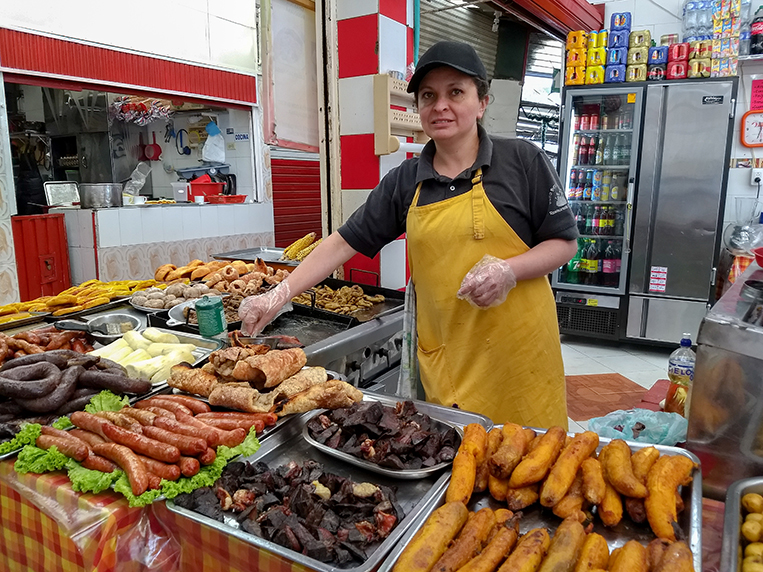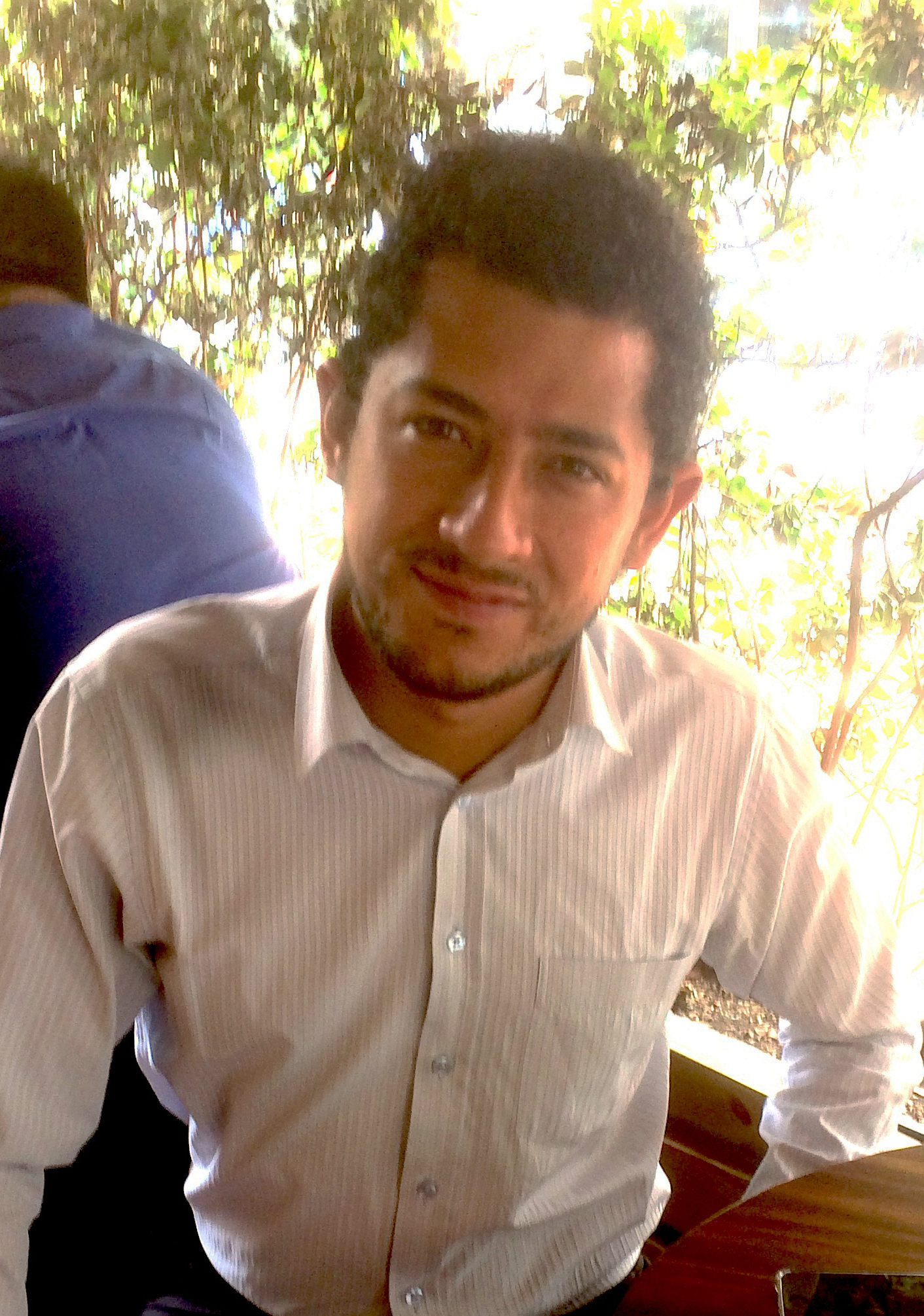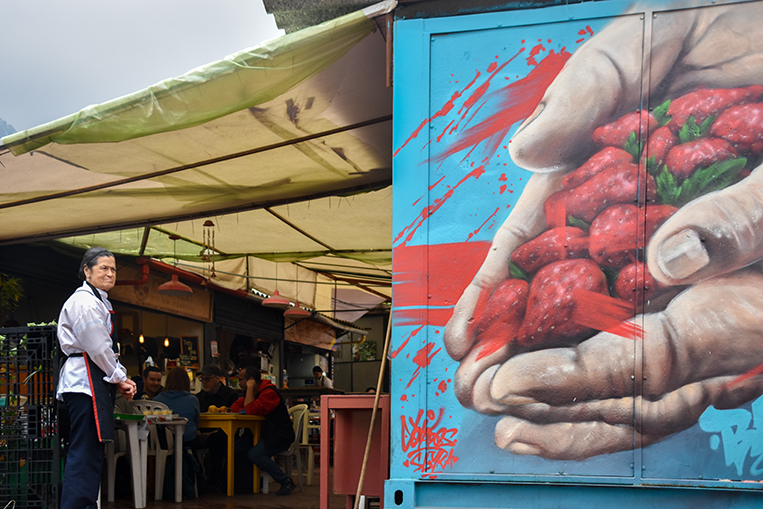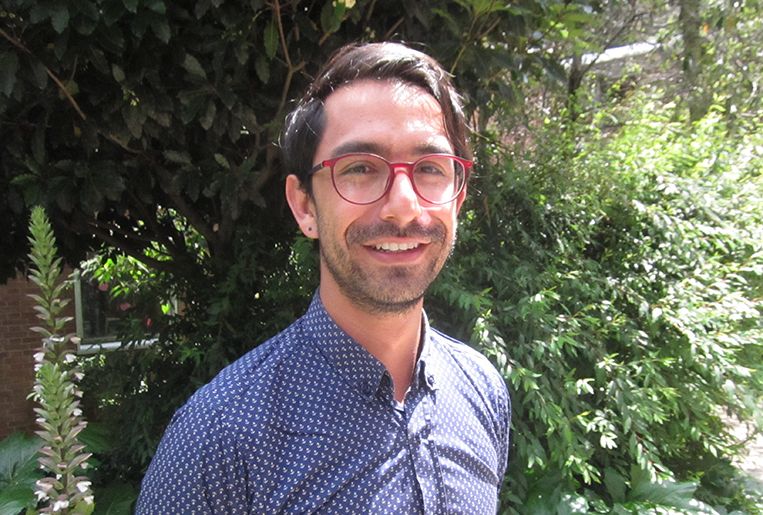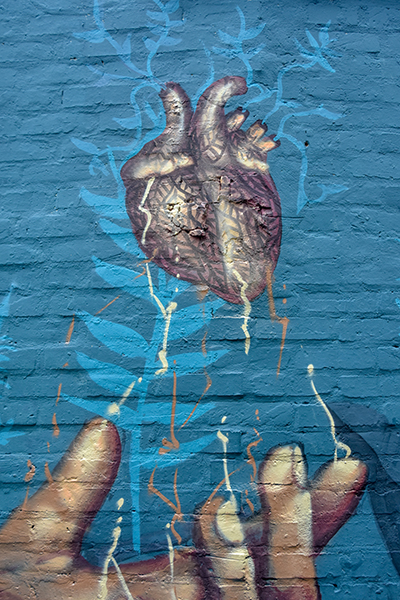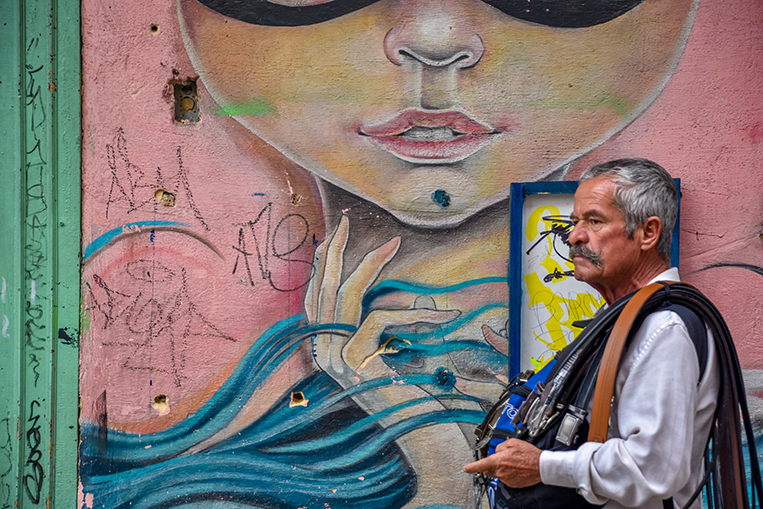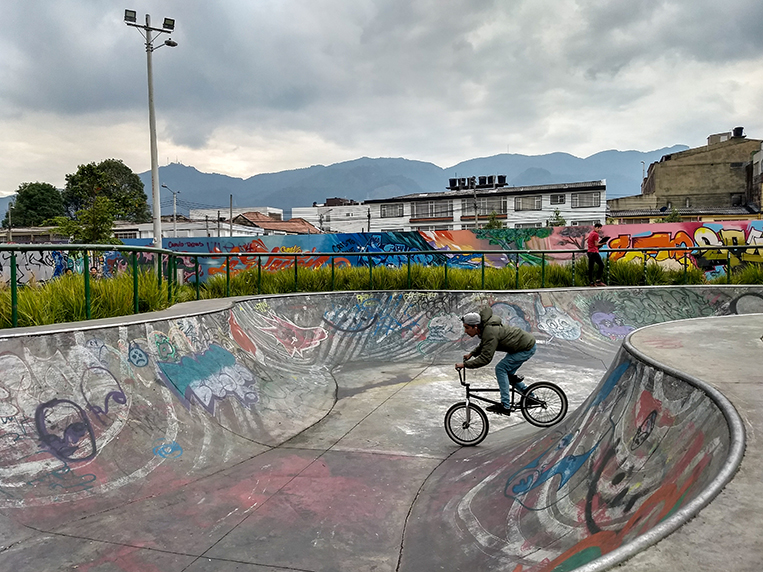Forgive me for a moment while I indulge in an old-fashioned description of Bogotá, the capital of Colombia. Rest for a moment. You are oxygen starved and flushed despite the chill of the mountain air. You have ridden a funicular up to the eighteenth-century Church of the Fallen Lord atop Monserrate, on the eastern lip of the mountains that ring the city. The mountains are verdant. There are copses of wagging green wax palms and sibilant clusters of Colombian oaks. Drifting over from the open-air restaurants behind the church come the smells of wood smoke and grilling chorizo. You’re leaning against a protective stone wall along the cliff edge, staring down from an elevation of 10,000 feet onto the valley fourteen hundred feet below.
Pilgrims have been climbing to this hilltop for centuries, often on their knees. Behind you the church has positioned fourteen bronze sculptures depicting the Stations of the Cross. Number eleven features a Roman centurion pounding a spike into the arm of the naked Christ. No doubt it once seemed an apt metaphor for the civil wars and violence that troubled Colombia. Twenty years ago, Medellín, the country’s second largest city, was the most dangerous city in the world (the murder rate reached 381 murders per 100,000 people, compared to the current murder rate in New York City of less than 4 killed per 100,000).
2._pob_8879.jpg
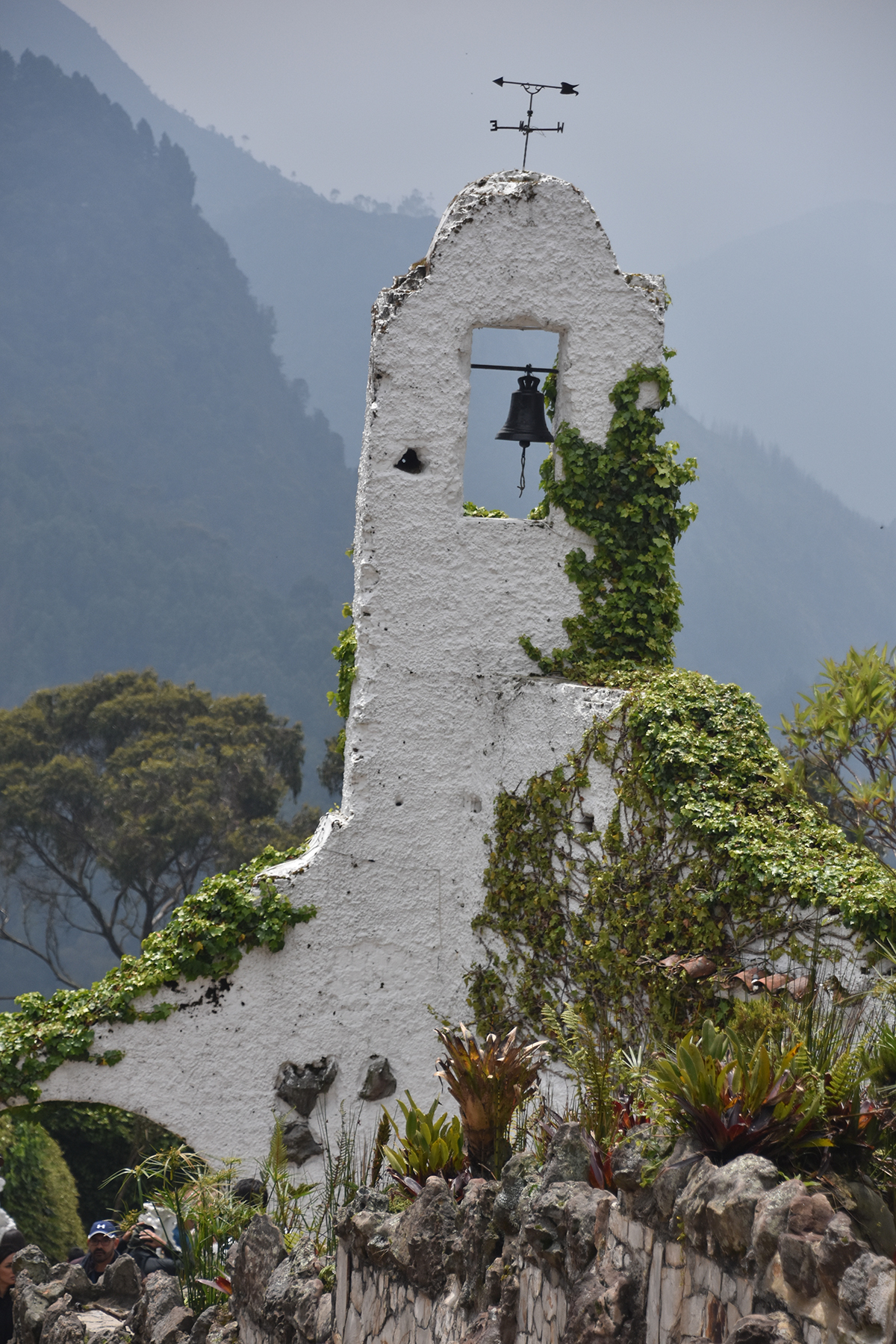
Bogotá stretches out beneath you. From here, the city lies obscured under the afternoon haze, like an aging starlet under a bubble bath: mischievous, flirtatious, pliable. Only the skyscrapers of the financial district and the Torres del Parque above the bullfighting ring jut up above the haze, stretching invitingly toward the tropical sun.
The old Bogotá was reputed to be a land of frightening violence but also great beauty. The actors included drug lords, Marxist guerillas, government death squads, and the American Drug Enforcement Agency. Internal divisions were enflamed by the regional players in the Cold War. The assassination of a popular political leader in 1948 led to a decade of chaos and killings. In the 1960s, frustrated leftist professors became activist guerilla leaders. In the 1970s, profitable illegal exports of marijuana to the United States evolved into a gushing cocaine pipeline. No one was entirely to blame, but no one was entirely innocent either. In such an environment, it seems a small miracle that writers continued to write, but they did. In the worst of times, Gabriel García Márquez was awarded the Nobel Prize for novels bubbling with legend, passion, romance, and tragedy. Marquez died in 2014, but Colombian writers have continued to produce some of the most celebrated fiction on the planet.
Colombia still has its problems, but incidences of murder and violent crime have fallen to rates roughly equal to our North American cities. Two years ago the government ratified a peace treaty with the Marxist guerillas. The drug traffickers that once claimed Colombian territory are said to be terrorizing Mexico now. So maybe now is the time to let Colombia relinquish its status as the reigning Wild West. Maybe now is the proper moment to describe it as beautiful without the underpinnings of violence. Maybe now is the time to meet with the country’s writers and listen as they explain how artists emerge from a war zone and learn to put a century of trauma behind them.
![]()
“One of the strangest ideas any Spanish conquistador could have ever had was to found a city here twenty-six hundred meters over sea level,” says Juan Gabriel Vásquez, echoing sentiments expressed by the narrator of his 2011 novel about the Colombian drug trade, The Sound of Things Falling, originally published in Spanish and released in English by Riverhead Books in 2013.
Seated beside me on a tasteful modern sofa in his living room, the author watches me through rimless glasses and explains that at the beginning of the twentieth century it took European visitors to Bogotá a couple of weeks to cross the Atlantic by boat and then another seven days to work their way from the coast to the elevated capital. Vásquez is happy to search the past for clues about the present, and he theorizes that the capital’s remote location has negatively impacted the local character.
“Bogotanos are a closed people,” he says, “not easy.” Vásquez is disappointed with the millions of Bogotanos who voted against a 2016 referendum concerning the peace process. The majority of citizens in the capital voted No, whereas Colombians in the most war-torn areas voted overwhelmingly in favor of peace. The author blames a lack of empathy, and he blames religious conservatism and racial intolerance. “When your capital city, historically, does not accept diversity—racial diversity or foreigners, except the Europeans they look up to—it makes for a complicated present.”
Vásquez, who is a well known author in both Colombia and abroad, has invited me to visit with him to speak about Colombian writing in the apartment he shares with his wife and twin daughters in the tree-lined, upscale northeast corner of the capitol city.
“Before Márquez there were few novelists, but poetry, we have always had great poets,” he says. He reminds me that one of Bogotá’s nicknames is ‘The South American Athens’ and tells me that, before he could read, he remembers using the books from the shelves of his parents’ home as building blocks. As a student at the private Anglo Colombian School of Bogotá, Vásquez was bilingual from a young age, and he recalls when he was a nine-year-old soccer fan that his father bought him a biography of the soccer star Pelé in English then paid him to translate it into Spanish.
“I don’t remember a time in which I was not writing,” he says. “I published a short story in the school paper when I was eight.”
Juan Gabriel VásquezAll the same, Vásquez did not aspire to be a writer as a young man. His father, mother, aunts and uncles were all lawyers. “In the ‘80s, in my social milieu, it wasn’t really easy to think about being a novelist,” he says. He attended law school at Universidad del Rosario, a private university founded by the Dominicans in 1643. But upon graduation, he handed his parents his diploma and moved to Paris to study literature in Spanish at the Sorbonne and start writing in earnest. By age twenty-six, he had published two novels but wasn’t satisfied with them. “I made this mess of a book with techniques from Woolf’s stream of consciousness, Faulkner’s time shifts, Vargas Llosa’s dialogues,” he says. His first two novels were simply a rehearsal, he explains. Searching for a new path, Vásquez accepted an invitation to stay a week with some friends in the Ardennes Forrest in Belgium. A week turned into a month, then three months and nine. The house was ten minutes from the nearest village, thirty minutes from Liege, far enough that he could avoid distractions. During his retreat, he rediscovered Joseph Conrad and the Spanish novelist Javier Marías. And then, “At the very end of my stay, I read a book I found by chance, maybe at an airport or train station, it was—I hope I’m remembering this correctly—American Pastoral by Phillip Roth.”
Emerging from the Ardennes reinvigorated and ready for his next step, he married his girlfriend, Mariana Montoya, a Colombian professional. The pair moved to Barcélona, where Vásquez completed and published The Informers (Riverhead Books, 2010), the first book he feels reflects his voice. After writing three more novels and living for sixteen years in Europe, Vásquez returned with his wife and twin daughters to Bogotá in 2012. We talk about the pillars of Colombian literature, pausing where all discussions about Colombian writers quickly land, on Gabriel García Márquez. Vásquez describes the prejudice Márquez overcame as a young writer. The intellectuals of the capital assumed that great writers could only arise from the urban upper classes and not from a provincial, coastal village. “He suffered from the old centralism of Colombian literature,” Vásquez says.
Vásquez sees Márquez’s early novels as necessary rungs on the ladder toward the Nobel Prize winner’s eventually apotheosis as the éminence grise of Colombian letters. “Leaf Storm [Márquez’s first novel] is so Faulknerian it is almost a caricature,” he says. “No One Writes to the Colonel is almost a rewriting of Old Man and the Sea; In Evil Hour is La Peste [The Plague by Albert Camus], and then there is One Hundred Years of Solitude, maybe one of the most perfect novels in the world.”
Vásquez credits the mature Márquez with transforming literature and, in the process, cementing the confidence of Colombian writers. “He didn’t have One Hundred Years of Solitude to step on; I did. I have received a tradition: a word that comes from the Latin root meaning ‘to give.’ He has given me the book that has enabled me to write the books I have written.”
On the coffee table before us, the author’s mobile phone rings. He apologizes for interrupting our talk and explains that he received word last night that he has won a literary award in Portugal and must fly to Lisbon in the morning.
I glance around the room, admiring an antique mantel clock on a shelf behind us and a framed lithograph of a pair of billiards players—a work by the Colombian painter Saturnino Rodriguez, referenced in Vásquez’s The Sound of Things Falling—above a white brick fireplace. The possessions return me to the theme of class and privilege. Would it have been possible for Vásqez to have succeeded if he hadn’t been born into a privileged family?
“Culture still has an elitist side in Colombia,” the author admits as he returns to our conversation. “Books are expensive. Reading a serious book takes hours, and people who spend four hours a day commuting on a difficult transportation system don’t have that time.”
On the other hand, he points out that even in a country where the civic commitment of the people is constantly being questioned, the government and the citizens are quick to make books available for the poor. “Any kind of cultural event, a reading or a conversation between writers, will just fill up with people,” he says. “People are thirsty for books.”
pob_8925.jpg [3]
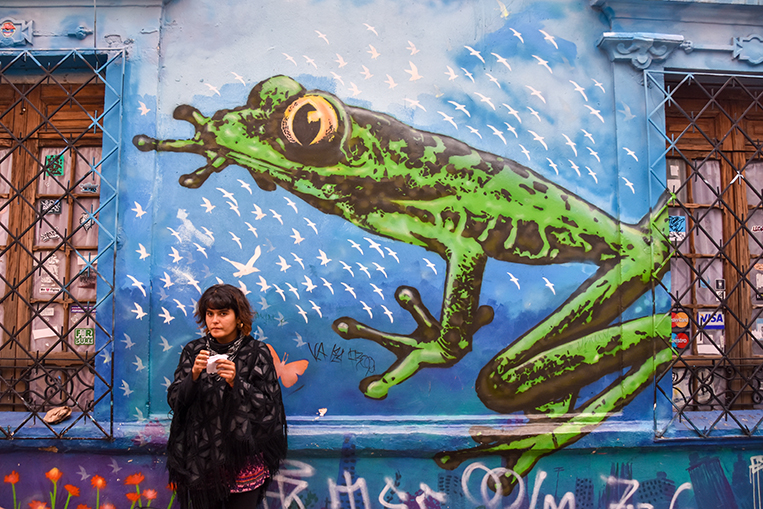
He reminds me that as part of a government initiative to reinvest in Medellín, the second largest city in the country and capital of the mountainous Antioquia province, authorities built libraries in the city’s most violent neighborhoods. “Twenty years ago, it was the most violent place in Colombia, and now it is a model city, largely due to libraries being built in places where you could not walk,” he says. It seems a liberal fantasy, yet news reports in the New York Times, the Economist, Forbes, CNN, the Guardian, and countless Spanish language outlets trumpet the success of the initiative. Beginning in 2004, ten libraries were built in the centers of small grassy parks in ten troubled neighborhoods. Serving also as community centers and technology centers, the public projects helped to introduce safe spaces and resources into the most crime-infested barrios.
“Colombia still has a little way to go before becoming a full-fledged, egalitarian, tolerant democracy, which is what I would like it to be,” Vásquez says, “but it is making an effort.”

